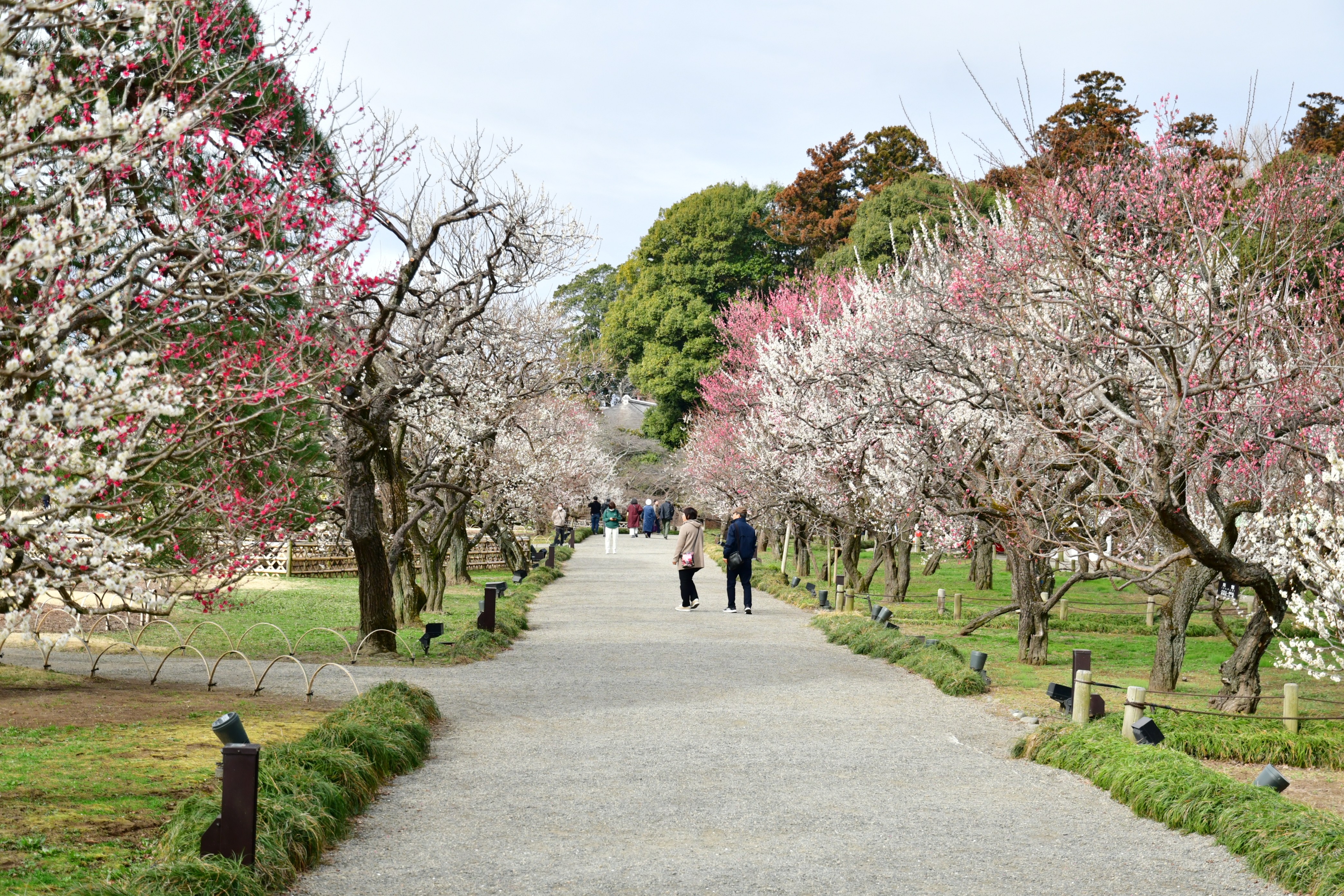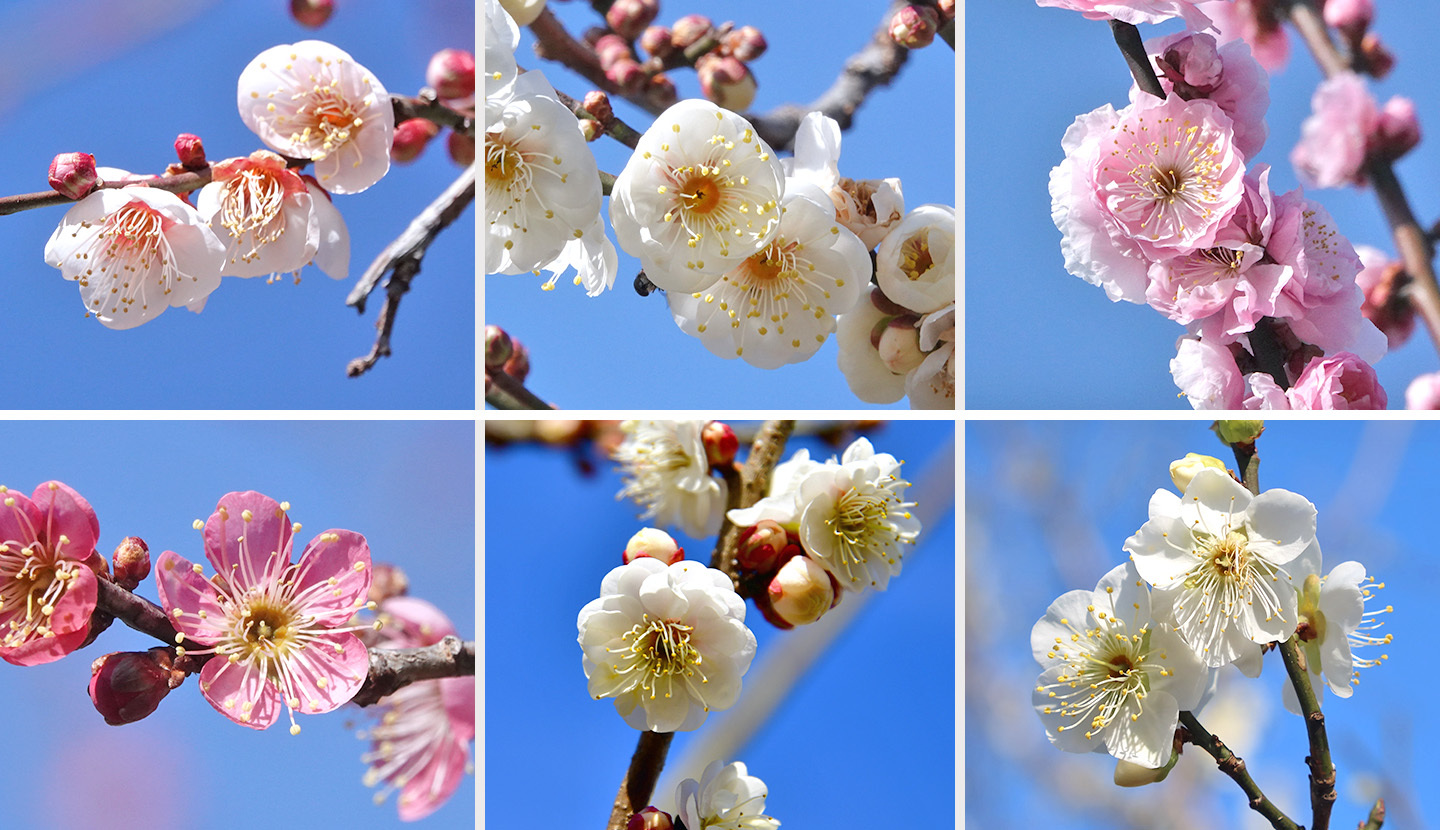Kairakuen: One of the Three Major Japanese Gardens, and a Historic Spot to View Japanese Plums
2024.12.13

Kairakuen, located at Mito City (Ibaraki Prefecture) and known for its plum grove, is one of the three major Japanese Gardens, along with Kenrokuen (Ishikawa Prefecture) and Korakuen (Okayama Prefecture). In early spring, the garden is adorned with 3,000 plum trees in full bloom, filling the air with a refreshing fragrance.This article details the garden's beauty and origin, historical buildings, cultural characteristics, recommended walking routes within the garden, and related spots such as Kodokan and Mito Castle.
Plum Blossom Festival, and Beauty Throughout the Year

Picture courtesy of Kairakuen
Kairakuen is famous for its plum blossoms. There are around 100 varieties totaling 3,000 trees, blooming from early February to late March. Depending on the variety, the blooming periods vary, with ‘early blooming,’ ‘mid-blooming,’ and ‘late blooming,’ allowing visitors to enjoy the flowers for over a month.

Six Famous Trees of Mito Picture courtesy of Kairakuen
Among them, there are six special plum trees called ‘Mito’s Six Famous Trees,’ surrounded by bamboo fences, and they are known for their distinctive flower shape, fragrance, and color.

Picture courtesy of Kairakuen
Mito Plum Blossom Festival, nationally known as an early spring event, has a history of more than 120 years. The trees are lit up at night, and there are fireworks, tea ceremonies, plum liqueur tastings, and martial arts demonstrations. The main venues are Kairakuen and Kodokan, the former Mito domain school. Along with plum blossom viewing, visitors can also enjoy Japanese traditional culture.

Picture courtesy of Kairakuen
Besides plum trees, Kairakuen also boasts lush green bamboo grove that can be enjoyed year-round.The garden also offers seasonal beauty, with cherry blossoms in spring, vibrant red Kirishima azaleas in early summer, and hagi flowers and autumn foliage in fall.
Information

Mito Plum Blossom Festival
The Mito Plum Blossom Festival began in 1896 when the railway between Mito and Ueno opened, and trains for viewing plum blossoms were implemented. The festival is held annually from mid-February to l…
See MoreThe Origins and History of Kairakuen

Picture courtesy of Kairakuen
Kairakuen, one of the ‘Three Great Gardens of Japan,’ is a place where nature and classical Japanese beauty merge. The garden soothes the visitors with a touch of history and culture throughout the year.
Kairakuen was established in 1842 by Tokugawa Nariaki, the 9th lord of the Mito Domain (in the Edo period (1603–1868), the central and northern parts of present-day Ibaraki Prefecture).
In 1841, Nariaki established the domain school ‘Kodokan’ to cultivate talented individuals, providing a place for the children of local samurai to learn both academic subjects and martial arts.
On the other hand, based on the teachings of Confucius (the philosopher considered to be the founder of Confucianism, active in the 6th-5th century BCE) about ‘balance between tension and relaxation, and between wisdom and strength,’ Kairakuen was built as a place to rest the mind during study breaks.

Tokugawa Nariaki named it “Kairakuen” (偕楽園) with the hope that the garden (園) would provide comfort and peace to the samurai and the people of the domain, becoming a place to enjoy (楽) together (偕).

Picture courtesy of Kairakuen
Plum trees, the garden’s greatest attraction, were especially loved by Nariaki, who encouraged their cultivation as their pure and elegant flowers are among the first to bloom in early spring, and their fruit could be stored as food.

Picture courtesy of Kairakuen
Information

Kairakuen Garden
Kairakuen Garden is ranked among Japan’s top three most beautiful gardens, alongside Kenrokuen in Kanazawa and Korakuen in Okayama. The garden was established in 1842 by Nariaki Tokugawa, the ninth f…
See MoreKobuntei: A Historic Space of Culture and Scenery

Inside the garden built at the same time with it, there is a villa of Nariaki, called Kobuntei. Located between the bamboo and plum groves, the “Kobuntei” name is derived from kobun-boku, an alias of plum. Additionally, this name is also inspired by a phrase that is believed to have belonged to Emperor Wu of the Jin dynasty (an ancient Chinese dynasty that lasted from the 3rd century BCE to the 5th century CE), which states, ‘If one loves literature, plums bloom; if one neglects literature, plums do not bloom.’

Nariaki invited his loyal supporters, intellects, and the common people to Kobuntei, where they enjoyed banquets, including composing poems. The facility consists of two structures, a three-storied main building and a single-storied Okugoten (Inner Palace). Situated in an ideal location with breathtaking views, its design incorporates elaborate details and is said to have been personally directed by Nariaki.

The visitor’s route from the main entrance leads to the Okugoten.
There are more than ten rooms for the lord’s wife and her maids. Each room has intricate paintings that match its name, beautifully illustrated on the sliding doors (fusuma).

Rakujuro, the three-storied building, is Nariaki’s study, with a view to the east, west, and south.
It is said that Nariaki enjoyed the sight of the plum grove, greenery, and Lake Senba, while contemplating various matters.

Kobuntei was once destroyed in 1945 during the war, and the reconstruction, which started in 1955, took 3 years.
Cafe Raku

Inside Kobuntei, there is Cafe Raku, where visitors can enjoy delicious sweets while taking in a panoramic view of the garden.

Their signature dessert is tiramisu, served in a traditional wooden masu box. The plum-flavored tiramisu is especially visually striking. Its rich mascarpone cheese flavor is balanced by refreshing jelly and complemented by the tangy sweetness of plum flesh. This tiramisu also has a hidden secret, so be sure to visit and experience it for yourself. Seasonal flavors are offered as well.

Another recommendation is baika-cha, a herbal tea with cute plum buds floating on the surface. It has an elegant fragrance and a comforting effect.
A Stroll at Kairakuen: From the World of Yin to the World of Yang

The recommended route is to start from the Main Gate (Omotemon), walk through the bamboo and cedar groves (yin), to the plum grove (yang).
This contrasting design is a unique charm of Kairakuen, originating from the yin-yang harmony philosophy emphasized by Tokugawa Nariaki.

Upon entering the Main Gate, over 1,000 bamboo stalks of Moso bamboo stretch up to the sky, creating a serene atmosphere. The bamboo grove is surrounded by cedar trees.

Togyokusen, a natural spring that produces cool, clear water even in summer, is located in the lower grounds. This well has never run dry since the garden was built. Its water is said to be effective against eye disease, and was also used in tea ceremonies held at Kobuntei. Kansuiseki (white marble), produced in Ibaraki Prefecture, is used as a well curb. As it is continually eroded by water, the current curb is the fourth generation.

After the bamboo and cedar groves, Kobuntei will appear beyond the second gate (Kobuntei Nakamon).

The facility stands on the border of yin and yang, with a view of the plum grove and Lake Senba.

Picture courtesy of Kairakuen
After passing Kobuntei and going through Shibasakimon Gate, visitors arrive at the bright plum garden, the world of yang. Besides the plum trees’ garden, there is also a spacious lawn area with excellent views overlooking Lake Senba.
Historic Places Related to the Mito Domain
In Mito City, there are many historic spots related to the Mito Domain, where visitors can gain a deeper understanding about the local culture and history.
Kodokan Mito Domain School
 Picture courtesy of Kodokan
Picture courtesy of Kodokan
Kodokan, a school managed by the domain, was built in 1841 by Tokugawa Nariaki. It is a counterpart to Kairakuen, a place for rest and relaxation for both the body and mind.
The school was the largest of its kind at the time, where the children of local samurai could enter when they became 15 years old, and study literature and martial arts. Kodokan resembled a modern university, nurturing talented individuals in various fields.
From the 17th Century, the Mito Tokugawa Family emphasized studying history, and under the rule of Nariaki, education, science, and political studies flourished. Kodokan is the culmination of these efforts, and the philosophy of the school’s foundation became known throughout Japan.
The main gate, main hall, and Shizendo (the resting and study area of the lord) are designated as Important Cultural Properties of Japan. Approximately 800 plum trees of 60 different varieties are planted in this area, making it one of the most famous spots for viewing plum blossoms.
Information

Kodokan Mito Domain School
Kodokan was established in 1841 by Nariaki Tokugawa, the ninth feudal lord of the Mito Domain. It was the largest school among the warrior clan and comparable to a university by today's standards. St…
See More
Mito Castle
 Picture courtesy of Mito City
Picture courtesy of Mito City
Mito Castle was one of the largest eathern flat mountain castles in Japan. It is believed to have been constructed from the late 12th to early 13th century and became the residence of the Mito Tokugawa family in 1609.
Inside Mito Castle, there were not only the main tower and the lord’s residence, but also the Mito Shokokan, the bureau established by Tokugawa Mitsukuni, the second lord of Mito Domain. This bureau was responsible for compiling the monumental historical book of Japan, Dai Nihonshi. This book was not only significant for the people of the Mito domain but also played a key role in shaping the intellectual and educational culture of early modern Japan.
Most of the castle buildings were lost due to wars and other causes, but some parts of the castle, like the bulwark and the moat, remain. Some structures, such as the Otemon (Main Gate), were rebuilt, based on historic documents.
Information

Mito Castle Ruins
Mito Castle was Japan's largest earthen flatland castle, constructed between the late 12th to early 13th centuries. It became the Mito Tokugawa family's castle after several changes in lords when Y…
See More
Lake Senba
 Picture courtesy of Mito City
Picture courtesy of Mito City
Lake Senba, located to the southeast of Kairakuen, was formerly used for boats to approach Kairakuen. Originally a shallow pond, it was turned into a moat for Mito Castle in the early Edo period (1603 to 1868).
There are about 700 cherry trees along the lakeside, and Mito citizens gather at springtime to enjoy hanami (cherry blossom viewing).

Picture courtesy of Mito City
In August, a grand “Mito Komon Festival Fireworks” is held at Lake Senba, with 5,000 fireworks lighting up the night sky. The beautiful fireworks reflect on the surface of the lake, captivating many spectators each year.
Information

Lake Senba
Located in the heart of Mito City, Lake Senba is a great place to relax for locals and visitors alike. The lake is encircled by a 3-kilometer-long walking and jogging route near Kairakuen Garden an…
See More





